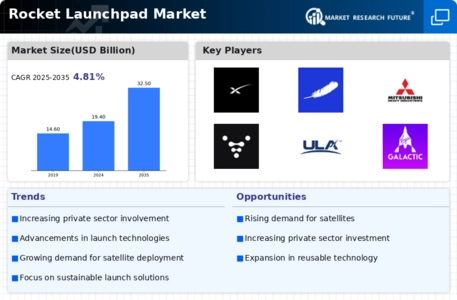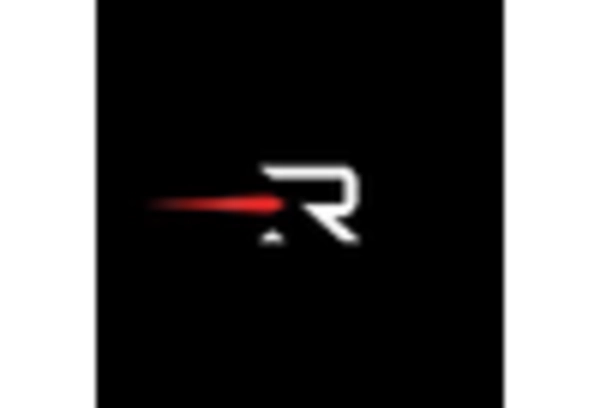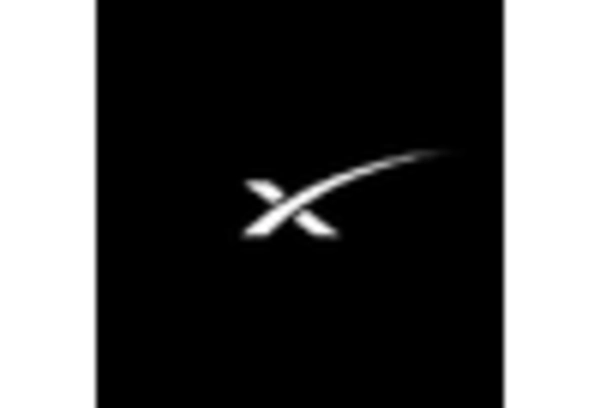Rise of Space Tourism
The emergence of space tourism is poised to transform the Rocket Launchpad Market. As private companies develop suborbital and orbital flight experiences for civilians, the demand for dedicated launch facilities is likely to increase. Recent estimates suggest that the space tourism market could reach a valuation of 3 billion dollars by 2030, prompting the need for specialized launchpads tailored to accommodate commercial spaceflights. This trend not only diversifies the types of missions conducted but also encourages investment in launch infrastructure. The Rocket Launchpad Market must adapt to these new requirements, potentially leading to innovations in launchpad design and operational protocols. The intersection of tourism and space exploration indicates a burgeoning segment within the Rocket Launchpad Market.
Increased Demand for Satellite Launches
The Rocket Launchpad Market experiences a notable surge in demand for satellite launches, driven by the growing need for communication, Earth observation, and scientific research. As nations and private companies invest in satellite technology, the number of planned launches is projected to rise significantly. According to recent data, the satellite launch market is expected to reach a valuation of over 30 billion dollars by 2026. This increase in satellite deployment necessitates the expansion and modernization of launch facilities, thereby propelling the Rocket Launchpad Market forward. Furthermore, advancements in miniaturization technology allow for smaller satellites, which could lead to more frequent launches, further stimulating the market. The interplay between technological innovation and market demand suggests a robust growth trajectory for the Rocket Launchpad Market.
Government Investments in Space Exploration
Government investments in space exploration significantly influence the Rocket Launchpad Market. Various countries are increasing their budgets for space programs, recognizing the strategic importance of space capabilities. For instance, recent reports indicate that national space agencies are allocating billions of dollars towards developing new launch facilities and upgrading existing ones. This influx of funding not only enhances the infrastructure necessary for launches but also stimulates collaboration with private sector entities. The partnership between government agencies and commercial launch providers is expected to create a more dynamic Rocket Launchpad Market, as it combines public resources with private innovation. The sustained commitment to space exploration suggests a long-term growth potential for the Rocket Launchpad Market.
Technological Advancements in Launch Systems
Technological advancements play a pivotal role in shaping the Rocket Launchpad Market. Innovations in launch systems, such as reusable rockets and automated ground support equipment, enhance the efficiency and cost-effectiveness of space missions. The introduction of reusable launch vehicles has the potential to reduce launch costs by up to 30%, making space access more affordable for a wider range of entities. Additionally, the integration of advanced telemetry and tracking systems improves launch precision and safety. As these technologies continue to evolve, they are likely to attract more stakeholders to the Rocket Launchpad Market, fostering a competitive environment that encourages further innovation. The ongoing research and development efforts in this sector indicate a promising future for the Rocket Launchpad Market.
International Collaboration in Space Missions
International collaboration in space missions is becoming increasingly prevalent, impacting the Rocket Launchpad Market. Joint missions between countries and organizations facilitate knowledge sharing and resource pooling, which can lead to more efficient launch operations. Recent initiatives, such as collaborative satellite projects and shared launch facilities, exemplify this trend. These partnerships often result in the establishment of multi-use launchpads that can accommodate various types of missions, thereby optimizing resource utilization. The growing trend of international cooperation suggests that the Rocket Launchpad Market will benefit from enhanced operational capabilities and reduced costs. As nations work together to achieve common goals in space, the Rocket Launchpad Market is likely to see a shift towards more integrated and collaborative launch strategies.


















Leave a Comment